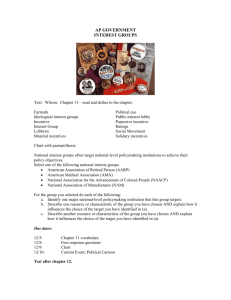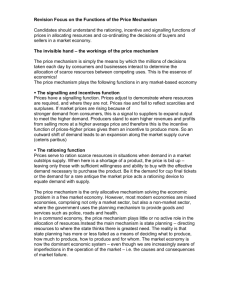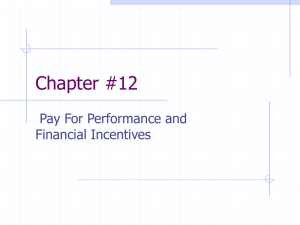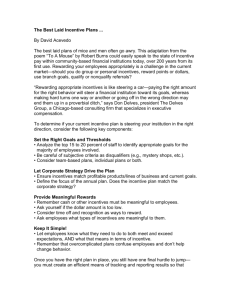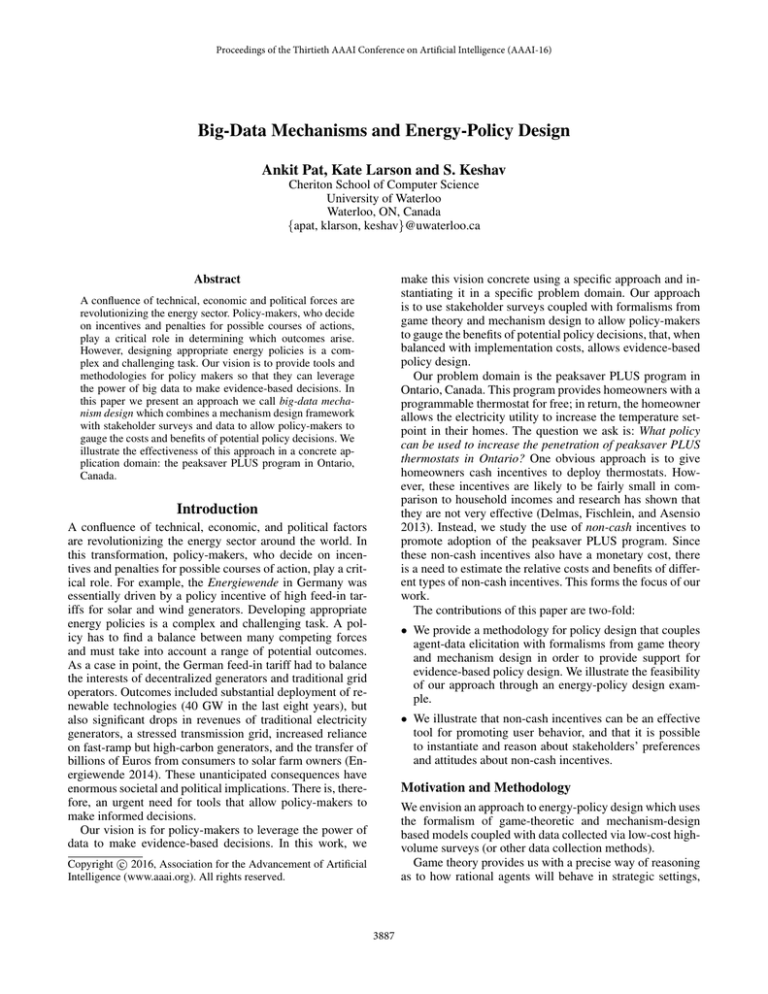
Proceedings of the Thirtieth AAAI Conference on Artificial Intelligence (AAAI-16)
Big-Data Mechanisms and Energy-Policy Design
Ankit Pat, Kate Larson and S. Keshav
Cheriton School of Computer Science
University of Waterloo
Waterloo, ON, Canada
{apat, klarson, keshav}@uwaterloo.ca
make this vision concrete using a specific approach and instantiating it in a specific problem domain. Our approach
is to use stakeholder surveys coupled with formalisms from
game theory and mechanism design to allow policy-makers
to gauge the benefits of potential policy decisions, that, when
balanced with implementation costs, allows evidence-based
policy design.
Our problem domain is the peaksaver PLUS program in
Ontario, Canada. This program provides homeowners with a
programmable thermostat for free; in return, the homeowner
allows the electricity utility to increase the temperature setpoint in their homes. The question we ask is: What policy
can be used to increase the penetration of peaksaver PLUS
thermostats in Ontario? One obvious approach is to give
homeowners cash incentives to deploy thermostats. However, these incentives are likely to be fairly small in comparison to household incomes and research has shown that
they are not very effective (Delmas, Fischlein, and Asensio
2013). Instead, we study the use of non-cash incentives to
promote adoption of the peaksaver PLUS program. Since
these non-cash incentives also have a monetary cost, there
is a need to estimate the relative costs and benefits of different types of non-cash incentives. This forms the focus of our
work.
The contributions of this paper are two-fold:
Abstract
A confluence of technical, economic and political forces are
revolutionizing the energy sector. Policy-makers, who decide
on incentives and penalties for possible courses of actions,
play a critical role in determining which outcomes arise.
However, designing appropriate energy policies is a complex and challenging task. Our vision is to provide tools and
methodologies for policy makers so that they can leverage
the power of big data to make evidence-based decisions. In
this paper we present an approach we call big-data mechanism design which combines a mechanism design framework
with stakeholder surveys and data to allow policy-makers to
gauge the costs and benefits of potential policy decisions. We
illustrate the effectiveness of this approach in a concrete application domain: the peaksaver PLUS program in Ontario,
Canada.
Introduction
A confluence of technical, economic, and political factors
are revolutionizing the energy sector around the world. In
this transformation, policy-makers, who decide on incentives and penalties for possible courses of action, play a critical role. For example, the Energiewende in Germany was
essentially driven by a policy incentive of high feed-in tariffs for solar and wind generators. Developing appropriate
energy policies is a complex and challenging task. A policy has to find a balance between many competing forces
and must take into account a range of potential outcomes.
As a case in point, the German feed-in tariff had to balance
the interests of decentralized generators and traditional grid
operators. Outcomes included substantial deployment of renewable technologies (40 GW in the last eight years), but
also significant drops in revenues of traditional electricity
generators, a stressed transmission grid, increased reliance
on fast-ramp but high-carbon generators, and the transfer of
billions of Euros from consumers to solar farm owners (Energiewende 2014). These unanticipated consequences have
enormous societal and political implications. There is, therefore, an urgent need for tools that allow policy-makers to
make informed decisions.
Our vision is for policy-makers to leverage the power of
data to make evidence-based decisions. In this work, we
• We provide a methodology for policy design that couples
agent-data elicitation with formalisms from game theory
and mechanism design in order to provide support for
evidence-based policy design. We illustrate the feasibility
of our approach through an energy-policy design example.
• We illustrate that non-cash incentives can be an effective
tool for promoting user behavior, and that it is possible
to instantiate and reason about stakeholders’ preferences
and attitudes about non-cash incentives.
Motivation and Methodology
We envision an approach to energy-policy design which uses
the formalism of game-theoretic and mechanism-design
based models coupled with data collected via low-cost highvolume surveys (or other data collection methods).
Game theory provides us with a precise way of reasoning
as to how rational agents will behave in strategic settings,
c 2016, Association for the Advancement of Artificial
Copyright Intelligence (www.aaai.org). All rights reserved.
3887
whereas mechanism design focuses on describing how policies should be designed so as to ensure the incentives are in
place so that desirable outcomes (often measured in terms of
agents’ preferences) arise. Despite its power and widespread
usage, we see several limitations with these formal frameworks when it comes to energy-policy design.
First, at its core, there is a strong assumption that the
agents in question are fully rational, whereas there is significant evidence from behavioral economics that this assumption has limited merit (Ariely 2008; Camerer 2003;
Wright and Leyton-Brown 2010). We, on the other hand, are
interested in cognitive biases and decision-making supports
used by agents and how these could be leveraged when designing incentives.
Second, in much of the economics (and game-theoretic)
literature agents’ beliefs and preferences are treated as abstractions (Parkes and Wellman 2015), whereas with the advent of easy access to data, we argue that one should use
this data to better model and instantiate the agent population, thus improving the analysis, predictions and robustness
of models.
In this paper, we present a methodology for designing and evaluating policies using available data to model
the underlying agent population and emphasizing the use
of non-cash incentives (by leveraging cognitive biases and
other decision-making supports). We describe the policy
space, utility functions and goals of the different players using game-theoretic formalisms, but then use low-cost highvolume surveys to gather information about the effectiveness
of non-cash incentives and use this information to model a
population of agents with utility functions derived from the
survey data. We test and evaluate different policies on this
population, allowing the policy-maker the flexibility to experiment and determine the marginal benefit of alternative
policy-design choices.
Our work complements several research themes. First, the
use of surveys for policy evaluation is not a new idea in
the energy domain (see, for example (DeCicco et al. 2014)).
However, these surveys tend to be labor intensive, expensive to conduct, and often focus on post hoc analysis. We,
instead, envision the use of low-cost high-volume data collection (through surveys or other means) that would allow
for the modeling of agents’ preferences within a population,
on which alternative policies could be evaluated.
Econometric analysis of strategic settings is an interesting
recent research direction (see, for example (Bajari, Hong,
and Nekipelov 2013; Nekipelov, Syrgkanis, and Tardos
2015; Chawla, Hartline, and Nekipelov 2014)). Much of this
work focuses on learning preference information and other
game parameters via the strategic interactions of agents. Instead, we use data to learn agents’ attitudes towards different
incentive schemes and incorporate this into utility functions
for analysis. Our work arguably falls within a preference
elicitation framework (e.g. (Goldsmith and Junker 2009))
though to the best of our knowledge we are the first to use
our proposed methodology for policy design, particularly
in the energy sector. Finally, we see parallels with empirical mechanism design (Vorobeychik, Kiekintveld, and Wellman 2006). In the empirical mechanism design framework,
learning and search techniques are used to estimate outcome
features of interest as a function of mechanism parameters.
While our methods are different, we also envision a framework where policy designers can experiment with alternative
policy-features.
peaksaver PLUS
To illustrate our methodology, we use the peaksaver PLUS
program, run by the Ontario Power Authority in Canada as
an example. In this program, eligible participants (i.e. homeowners with a central air conditioner) are offered a free programmable thermostat. In exchange, on hot summer days,
when electricity demand is at its highest, a signal is sent to
the thermostats to increase the temperature setting by up to
2 degrees Celcius, thus reducing the central air conditioner’s
energy demands. If there are enough participants, then the
program is able to reduce load on the system as a whole,
thus ensuring wide adoption of the program is of interest to
the corporation. Participants are provided with a free thermostat and should see some savings on their electricity bills,
however will experience some discomfort as their thermostat
settings are increased during certain periods of the summer.
Formal Model
In this section we present our formal model for the eligible participants (who we call agents) and the corporation
(which we call the principal). At a high-level, the principal’s goal is to reduce energy load across the system and can
do this by increasing the temperature setting of agents’ thermostats. The challenge, however, is that the agents have the
freedom to participate in the program or not, and so the principal must offer incentives so as to encourage participation.
This induces a tension where the principal must determine
which incentives to offer so as to encourage agents to participate, while at the same time keeping its own costs as low as
possible, whereas the agents prefer to experience no change
in the temperature setting, but might be willing to accept
certain (non-cash) incentives in exchange for experiencing
some thermal discomfort.
The Principal
Let I be the set of (non-cash) incentives the principal may
offer, and let θi ∈ {0, 1} be a variable where θi = 1 if
the principal offers incentive i ∈ I and θi = 0 otherwise.
We additionally assume that when the principal offers some
incentive i ∈ I, it incurs a cost Ci . An incentive policy is
specified by a vector P in = (θ1 , . . . , θ|I| ) indicating which
incentives are offered by the principal. The cost
associated
with a particular incentive policy is cost(P in ) = i∈I Ci θi .
A policy, P , is an incentive policy coupled with a (homogeneous) temperature increase, ΔT , the principal wishes to
implement. That is, P = P in , ΔT .
We assume that there is some minimal level of agent participation the principal requires before it will implement a
policy, and we denote this minimum threshold as λ∗ . Given
a policy, P , we let λ(P ) be the number of agents willing to
participate in the program given the policy. Given these con-
3888
ditions, we can specify the principal’s optimization problem:
maximizeP λ(P )ΔT − i Ci θi
(1)
subject to
λ(P ) ≥ λ∗ .
campaign could be used to provide the message that the
program is heavily adopted and has positive environmental impact, along with other desirable features the general
population may care about.
The Agents
Gamification: This refers to the use of game design elements in non-game contexts (Deterding et al. 2011).
In our application domain this could include giving out
points depending on energy savings and including such
information on leader boards or through badges.
We assume there is a set of N agents (i.e. eligible participants) who each derive some utility from a policy
P = (θ1 , . . . , θ|I| ), ΔT ,
offered by the principal. In particular, for each incentive
i ∈ I we assume agent j derives utility wij when the incentive is provided. Similarly, we assume that each agent
has a preferred temperature setting and experiences discomfort d(ΔT ) for any temperature change ΔT . An agent’s total
utility, given policy P , is thus the linear combination
j
wi θi − d(ΔT ).
(2)
Uj (P ) =
In concrete terms, a policy for the principal is a combination of the above incentives, coupled with a temperature
increase ΔT .
Instantiating the Model: Using Surveys to
Elicit Preferences
To elicit agents’ preferences we conducted a survey to learn
how agents react to the different non-cash incentives and
to derive information about agents’ thermal discomfort and
preferred baseline temperature. We used CrowdFlower1 for
recruiting participants (with the geographical restriction that
they must be in Canada or the United States), SurveyMonkey2 to host the survey, and paid 1 USD to each participant. We had 990 responses and after a data cleaning process
where we removed incomplete responses, duplicates based
on IP filtering, responses that failed to follow directions, and
those with very low variance across all questions, we were
left with 425 responses.
The survey was divided into multiple sections. We used
qualifier questions to gauge whether a respondent was a
member of our target population (i.e. a homeowner with
control of a thermostat). We then had a series of sections
where we asked questions designed to elicit respondents’ reactions to cognitive biases and non-cash incentives used in
our model, before concluding with sections designed to elicit
temperature preferences and relative preference-weights.
We used the survey responses to formulate a utility function for each respondent, which resulted in a population of
425 agents with different utility functions, where each utility
function took the form presented in Equation 2. In the rest
of this section we describe how we determined the utility
function parameters.
i∈I
No agent can be forced to participate in the program, and
so the action space of agent j is Aj = {opt in, opt out}
where the utility of opting out is 0. Thus, when presented
with a policy P , agent j will only decide to opt in if
Uj (P ) ≥ 0.
(3)
Otherwise, agent j will opt out. Knowing this, we can
rewrite λ(P ), defined previously, as
λ(P ) = |{j|Uj (P ) ≥ 0}|.
Instantiating the Model: The Policy Space
One of our main interests is using non-cash incentives in (energy) policy design and, in particular, we argue that cognitive biases and other decision-making supports can be leveraged in this domain, like in other domains (Ariely 2008;
Tversky and Kahneman 1974). In our study we included four
well-studied non-cash incentives in set I, which we describe
in the following.
Status Quo Bias: The status quo bias is that an agent
prefers to maintain the current situation or decision (Samuelson and Zeckhauser 1988). In our application domain, this could be implemented by enrolling
agents into the program by default, for example, by legislating that all new homes must be enrolled in peaksaver
PLUS.
Agents’ Utilities: Non-Cash Incentives
For each incentive i ∈ I we assume that each agent j assigned a weight wij indicating how strongly the presence of
that type of incentive influenced their overall utility. Furthermore, we assume that wij is separable such that wij = tji · Sij
where Sij is the strength of the incentive for the agent and tji
scales the incentive strength by the relative extent to which
incentive i was effective to overcome thermal discomfort, as
compared to other incentives.
Our survey was structured into separate sections for
each non-cash incentive. In each section we asked a set
Commitment Devices: A commitment device is a choice
made by agents to restrict their number of future choices,
and is often used as a way to reduce impulsive behavior (Bryan, Karlan, and Nelson 2010). In our application
domain, this could be implemented by using longer-term
contracts or making it possible to publicly acknowledge
one’s commitment to the peaksaver PLUS program, such
as a sticker on one’s door.
Social Norm Bias: The social norm bias simply states that
agents prefer to conform to the rules or a behavior that
is deemed acceptable by the larger group (Young 2008).
In our application domain, a carefully crafted advertising
1
2
3889
http://www.crowdflower.com
http://www.surveymonkey.com
Figure 1: The distribution of responses for every question eliciting non-cash incentive preferences.
Refrigerating and Air-Conditioning Engineers (ASHRAE)
Standard 55 (American Society of Heating, Refrigerating
and Air-Conditioning Engineers 2013). This allows us to
specify the thermal discomfort function as follows:
0
if |ΔT | ≤ 1.6
d(ΔT ) =
P M V (ΔT ) otherwise
of questions designed to elicit respondents’ attitudes towards the different incentives, where each respondent’s reply to a question was scored using a five point adjusted
Likert scale (Likert 1932; Lantz 2013) with scoring set
{0, 0.2, 2, 3.8, 4} to overcome the middle-of-the-scale effect (Lantz 2013). Figure 1 shows the raw survey results. To
determine Sij we computed the average psychometric score
for each bias.
We applied a scaling factor to each (average) psychometric score for each bias by asking each respondent the temperature increase, ΔTij they might be willing to accept for
each incentive class i ∈ I. We then set
tji = ΔTij
x∈I
ΔTxj
Results
Using a population of agents with utility functions extracted
from our survey data, we ran a series of experiments to determine how different policies changed participation rates
and what temperature changes we could support with which
incentive policies. Unless noted otherwise, we assumed that
the costs incurred by the principal for implementing each
incentive is zero.
In our first experiment we were interested in understanding how participation rates changed as a function of the policy, and how this influenced the principal’s actual goal of
maximizing the product λ(P )ΔT . Figure 2 shows the results for the incentive policy P in = (1, 1, 1, 1) (i.e. where
all incentives were deployed). As expected, participation decreased as ΔT increased, but, from the perspective of the
principal, drops in participation were offset by higher temperature increases. Given this particular incentive policy, we
observed that the optimal ΔT for maximizing the product
λ(P )ΔT was approximately two degrees Celsius.3
For each possible incentive policy (assuming zero cost)
we computed the optimal ΔT as shown in Figure 3. We observe that ΔT increased as more incentives were provided to
the agents. However this increase was not uniform and different combinations of incentives were able to support different ΔT .
Finally, for each incentive policy we computed the optimal ΔT , and then plotted the participation rate under that
temperature increase along with the principal’s objective.
The results are presented in Figure 4. We observe that participation rates decreased, but this is offset by participating
.
Agents’ Utilities: Thermal Discomfort
For our model we leverage the significant body of research
on determining thermal comfort for humans. Fanger proposed the Predicted Mean Vote (PMV) model to predict human comfort in different scenarios (Fanger 1970). The full
model depends on several factors including air temperature,
mean radiant temperature, air speed, humidity, metabolic
rate of the person and their clothing level. Since we are interested in the comfort level of humans inside homes, during
the summer, with a thermostat, we make a number of assumptions that reflect this. In particular, we assume humidity is equal to 50%, the mean radiant temperature is equal to
the air temperature, the airspeed is zero, the metabolic rate
is 1.2 met, and clothing level is 0.5 clo which represents typical summer indoor clothing (Hoyt et al. 2013). Using these
assumptions, we simplify the PMV model using a linear regression model. Under this specific criteria, the regressed
line fits
P M V (ΔT ) = 0.306|ΔT | − 0.48
with mean square error 0.02%, where ΔT is the temperature
change in Celsius.
A PMV of 0 is considered ideal, with the recommended
limits of PMV for ideal comfort being in the range of
[-0.5,0.5] according to the American Society of Heating,
3
We note that the current peaksaver PLUS policy is to also allow temperature increases of 2 degrees Celsius.
3890
Figure 2: Change in participation rate (bottom graph) and principal’s utility (top graph) as a function of ΔT when all incentives
are used.
Figure 3: Optimal ΔT for each incentive policy. We use the notation C for commitment device, S for status quo bias, G for
gamification and N for social norm.
agents accepting a higher ΔT in response to the provided
incentives.
Conclusion
Designing appropriate energy policies is a complex and
challenging task. Our research goal is to provide tools and
methodologies for policy makers so that they can leverage
the power of (big) data to make evidence-based decisions.
In this paper, using a concrete application of policy design for energy-use reduction, we showed how it is possible
to combine formal game-theoretic models and elicit preferences about non-cash incentives through low-cost highvolume surveys, in order to provide policy-makers the ability to gauge the costs and benefits of potential policy decisions.
We see numerous directions for future research. For example, we used a simple weighted-linear utility model and
assumed that there were no interdependencies between the
cognitive biases. One future research question would be to
see if richer utility models would provide additional insights
and benefits, given the additional challenges of elicitation
and instantiation they pose. We also used a model where the
principal applied a single policy across the entire population.
It is conceivable that there would be significant benefits to
While it is unrealistic to assume the principal has no costs
associated with providing different incentives, we also wish
to make no claims as to what those costs might actually be,
and thus did not instantiate the cost parameters Ci . However, we can compute the marginal benefit of adding different incentives to a policy and thus can provide the principal with information that allows it to determine how best to
use its own resources. For example, given the population we
surveyed, Table 1 describes the marginal benefit, in terms
of λ(P )ΔT , of adding additional incentives to policies. We
note that adding any incentive had a benefit compared to not
offering anything at all (i.e. as seen in the first row of Table 1). However, after that, given our survey population, we
see that the marginal benefit of including a status quo and social norm bias in the incentives was high compared to other
incentive structures.
3891
Figure 4: Participation rate (bottom graph) and principal’s objective as a function of the optimal ΔT for each incentive
policy (top graph). We used the notation C for denoting commitment device, S for denoting status quo bias, G for denoting
gamification and N for denoting social norm.
Current Policy
{}
{C}
{S}
{N }
{G}
{C, S}
{C, N }
{C, G}
{S, N }
{S, G}
{N, G}
{C, S, N }
{C, S, G}
{C, N, G}
{S, N, G}
Marginal Benefit (C)
462
24.4
5.2
5.2
Marginal Benefit (S)
462
24.4
26
19.6
24
26
3.2
11.6
16.4
Marginal Benefit (N)
462
5.2
26
0
4.8
Marginal Benefit (G)
462
5.2
19.6
0
6.8
11.2
11.2
8.8
15.2
34.8
50.8
48.8
63.6
45.2
Table 1: Marginal contributions of adding a particular incentive given a current incentive policy. The notation C represents
commitment device, S represents status quo bias, N represents social norm and G represents gamification.
ditions for human occupancy. ANSI/ASHRAE Standard 552013.
Ariely, D. 2008. Predictably irrational: The hidden forces
that shape our decisions. HarperCollins.
Bajari, P.; Hong, H.; and Nekipelov, D. 2013. Game theory and econometrics: A survey of some recent research. In
Advances in Economics and Econometrics. 3–52.
Bryan, G.; Karlan, D.; and Nelson, S. 2010. Commitment
devices. Annual Review of Economics 2:671–698.
Camerer, C. 2003. Behavorial Game Theory: Experiments
in Strategic Interaction. Princeton University Press.
Chawla, S.; Hartline, J.; and Nekipelov, D. 2014. Mechanism design for data science. In Proceedings of the Fifteenth ACM Conference on Economics and Computation
(EC 2014), 711–712.
DeCicco, J.; Yan, T.; Keusch, F.; Munoz, D. H.; and Neidert,
L. 2014. University of Michigan energy survey: Year one
report. University of Michigan.
Delmas, M. A.; Fischlein, M.; and Asensio, O. I. 2013. In-
allowing the principal to tailor different policies for different subsets of agents. One challenge to this approach, however, would be identifying interesting agent subpopulations.
As part of our research we experimented with a variety of
machine learning methods to learn utility models. However,
we had limited success. Further investigation in this direction is warranted to understand why this was so, and to determine what features are important to elicit from surveys or
other data sources so that machine learning can be added as
an effective part of the policy-design toolkit. For example,
it would be interesting to try to learn what features make
an individual react favorably to a particular incentive and
thus design more fine-grained, targeted policies. Finally we
are interested in illustrating our approach to policy-design in
other domains, both energy-based and beyond.
References
American Society of Heating, Refrigerating and AirConditioning Engineers. 2013. Thermal environmental con-
3892
formation strategies and energy conservation behavior: A
meta-analysis of experimental studies from 1975 to 2012.
Energy Policy 61:729–739.
Deterding, S.; Dixon, D.; Khaled, R.; and Nacke, L. 2011.
From game design elements to gamefulness: Defining gamification. In Proceedings of the 15th International Academic
MindTrek Conference: Envisioning Future Media Environments, 9–15. ACM.
Energiewende, A. 2014. The German Energiewende and its
climate paradox. Report 038/04-A-2014/EN.
Fanger, P. O. 1970. Thermal comfort: Analysis and applications in environmental engineering. Danish Technical Press.
Goldsmith, J., and Junker, U. 2009. Preference handling for
artificial intelligence. AI Magazine 29(4):9.
Hoyt, T.; Schiavon, S.; Piccioli, A.; Moon, D.; and
Steinfeld, K.
2013.
CBE Thermal Comfort Tool.
http://http://comfort.cbe.berkeley.edu/.
Lantz, B. 2013. Equidistance of Likert-type scales and validation of inferential methods using experiments and simulations. Electronic Journal of Business Research Methods
11(1):16–28.
Likert, R. 1932. A technique for the measurement of attitudes. Archives of Psychology 22(140):1–55.
Nekipelov, D.; Syrgkanis, V.; and Tardos, E. 2015. Econometrics for learning agents. In Proceedings of the Sixteenth ACM Conference on Economics and Computation
(EC 2015), 1–18.
Parkes, D., and Wellman, M. 2015. Economic resasoning
and artificial intelligence. Science 349(6245):267–272.
Samuelson, W., and Zeckhauser, R. 1988. Status quo bias in
decision making. Journal of Risk and Uncertainty 1:7–59.
Tversky, A., and Kahneman, D. 1974. Judgment under uncertainty: Heuristics and biases. Science 185:1124–1131.
Vorobeychik, Y.; Kiekintveld, C.; and Wellman, M. 2006.
Empirical mechanism design: Methods, with application to
a supply-chain scenario. In Proceedings of the 7th ACM
Conference on Electronic Commerce (EC 2006), 306–315.
Wright, J. R., and Leyton-Brown, K. 2010. Beyond equilibrium: Predicting human behavior in normal-form games.
In Proceedings of the Twenty-Fourth AAAI Conference on
Artificial Intelligence (AAAI 2010), 901–907.
Young, H. P. 2008. Social norms. In Durlauf, S. N., and
Blume, L. E., eds., New Palgrave Dictionary of Economics.
Palgrave Macmillan.
3893



